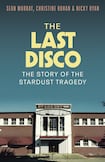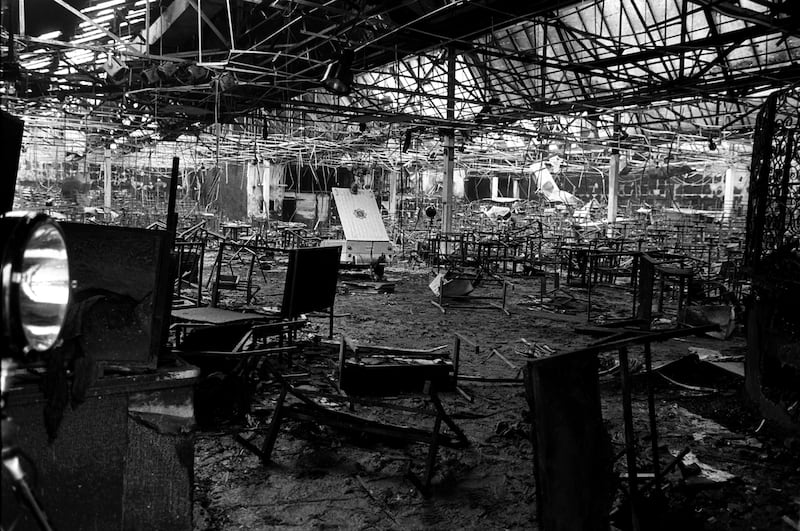
The year-long Stardust inquests, begun in April 2023 and held in The Pillar Room of Dublin’s Rotunda Hospital, comprised a comprehensive reinvestigation into how and, crucially, why, 48 young people lost their lives in the fire tragedy that took place on February 14th, 1981, in The Stardust Ballroom in Artane on the northside of Dublin.
Up to a further 200 people were injured on the night, some very seriously, with lifelong consequences. Alongside the deaths and injuries, severe intergenerational psychological damage was inflicted on an entire community.
At the momentous verdict of “unlawful killing”, given by the Stardust inquests jury on April 18th last, Stardust survivors and families of the “the 48″ finally had what they’d fought to get for 43 years: an explanation for why their loved ones had died.
Why did it take more than four decades to get the answers that any family would need for even a small sense of closure amid such profound and shocking loss? Why did devastated, traumatised parents and family members have to battle so long and so hard for justice – protesting, fundraising, lobbying politicians, conducting Dáil sit-ins – while trying somehow to continue with their lives?
In the process of answering these questions, The Last Disco: The Story of the Stardust Tragedy does what the State should have done back in 1981, and what it finally did do in 2023, by holding fresh inquests into the Stardust deaths. The book puts the families and survivors centre stage, treating them with compassion and respect, relaying and validating their truth with empathy and humanity. Alongside this, it meticulously asks why and how the Stardust disaster occurred, pointing at what still needs to be done to prevent something similar from happening again in Ireland.
Patrons’ desperate attempts at escape were thwarted by emergency exits that were chained and obstructed, bathroom windows over which metal plates had been welded, and staff who’d had no instruction nor any drills in what to do in the case of a fire or the need for evacuation
Co-written by three investigative journalists – Sean Murray, Christine Bohan and Nicky Ryan – who’ve also produced an award-winning Stardust podcast, The Last Disco is constructed from the words of the Stardust survivors, families and investigators. It’s clear that as well as conducting extensive research into the records going back more than half a century, the authors have spent long hours interviewing and getting to know many of the people directly involved in the Stardust justice campaign. These people’s personalities, relationships and stories are rendered through authorial techniques of dialogue and description that are characteristic of fiction.
This approach makes The Last Disco a gripping page-turner, deftly balancing information, analysis and human story. Its structure educates the reader on the complex history and wider implications of the Stardust tragedy, while avoiding fact-delivery overwhelm or fatigue. Its style keeps the reader’s emotions poignantly engaged without resorting to sensationalism.
The Last Disco offers a single location where we can go to get our heads around one of the worst disasters in recent Irish history. In its pages we can see beneath the surface to the inequalities and injustices in Irish society that the tragedy’s aftermath revealed, and its broader, ongoing ramifications concerning public safety and accountability for the whole of the Irish population, now and into the future.
The details of the fire scene deliver a real-life sense of the inferno which blazed up in The Stardust. Patrons’ desperate attempts at escape were thwarted by emergency exits that were chained and obstructed, bathroom windows over which metal plates had been welded, and staff who’d had no instruction nor any drills in what to do in the case of a fire or the need for evacuation. State authorities whose job was to protect the public were aware of the Stardust’s risks.
A photo in The Last Disco shows a large crowd of supporters and family members of The 48 in the Garden of Remembrance, where they walked from the Pillar Room after the verdict of unlawful killing was delivered at the inquests. Their expressions are beatific, their arms raised victoriously, holding aloft photos of the young people they lost in The Stardust; their search for truth and justice at long last vindicated.
Why is the crowd so jubilant about the verdict? The inquests that took place soon after their loved ones’ deaths in 1981 were restricted to the physical causes of death by fire and smoke, never broadening out to examine why the victims could not escape the fire and smoke. The Last Disco cleverly demonstrates the significance of the recent inquests’ conclusion that the Stardust victims had been unlawfully killed, using the example of a single-car collision in which a person dies.
“A verdict of accidental death could be returned if they simply lost control; it was unforeseen, and there were no other factors at play. Misadventure could be considered if the driver was speeding; the person died due to a risk they were taking. Unlawful killing could be returned if the crash was caused by a fault that the car’s manufacturer was aware of prior to the accident and had failed to address; someone was aware of potential harm and failed to take action.”
In advance of the recent fresh Stardust inquests, Stardust manager Eamon Butterly and his legal team tried and failed to have unlawful killing disallowed as a possible verdict.
In what is widely criticised as an act of classist victim-blaming, the first State investigation into the Stardust – the Keane Tribunal of 1981 – promulgated the erroneous official narrative that the fire had been caused deliberately, despite there being no evidence for this.
“It decided that the cause was not known but that it was probably arson,” write The Last Disco authors. The Keane Report was one of two tribunals in the 1980s – the other being the Kerry Babies Tribunal – which blamed the victims.
“[This] tells us what this is really about: social class and social power,” Fintan O’Toole wrote in The Irish Times. “By perpetrating a false narrative, the State put its weight behind a theory that ‘working class people are wild, reckless and the authors of their own calamities’.”
In the wake of the Keane Report, the northside Dublin community who’d had a generation of their offspring wiped out now had the added trauma of being labelled arsonists, responsible for the deaths of their own children.
At a pre-inquest hearing back in 2020, Daragh Mackin, human rights lawyer acting on behalf of the Stardust families, argued that the fresh inquests would draw “a line in the sand” on previous inquiries, adding that it would be argued that there was a “State-sponsored effort to cover up” what happened in the Stardust.
No prior investigation into the Stardust examined the source and reasons for the rapid spread of the fire as comprehensively as the Stardust inquests did in the last year. International fire experts were drafted in to re-examine the evidence. While legal parameters prevented the jury from stating there to be conclusive evidence for it, the jurists unanimously agreed that there was evidential basis for how the fire could have started in a hot press behind the bar.
‘Because of this catalogue of failures, the difference between life and death in the Stardust boiled down to mere seconds. If the evacuation had been conducted well with clear exits and trained staff, things might have gone much differently’
— The Last Disco authors
“The scale at which the carpet tiles contributed to the fire was put in stark terms,” write The Last Disco authors. “Once the roller blinds were lifted in the West Alcove, the fire was building with such ferocity that temperatures became untenable for human life within 52 seconds.
“The next line spelt it out even more baldly,” continue the authors. “‘The obstructions of the exits would have contributed to the loss of life.’... the time required for escape was longer than the time available for escape. Because of this catalogue of failures, the difference between life and death in the Stardust boiled down to mere seconds. If the evacuation had been conducted well with clear exits and trained staff, things might have gone much differently.”

In the wake of the unlawful killing verdicts, cold-case detectives were ordered to re-examine the potential for a criminal prosecution. The Last Disco quotes Mackin acknowledging that historical prosecutions in Ireland are very difficult to achieve. “But in many ways,” he adds, “whether or not a decision is taken to prosecute, it does not detract from the truth and does not detract from the truth of the verdict that was returned at the inquests of unlawful killing.”
Towards the end of The Last Disco, the authors again quote Mackin. “Some of these families have dedicated their entire lives,” he says. “They have given up everything to try and campaign for justice... to try to overturn that label of arson. We know now that’s not true. The very least the Government needs to do is put that right and ensure those who dedicated their time are adequately compensated.”
The Government, having apologised to the Stardust families for the “smear” and the ordeals they’ve been subjected to, is currently working on a redress scheme, with further details due to be announced soon.
Further reading
On Bloody Sunday: A New History of the Day and Its Aftermath – by Those Who Were There, by Julieann Campbell (Monoray, 2023)
Derry-born poet and campaigner Julieann Campbell’s teenage uncle was the first to be killed in the massacre of Bloody Sunday in Derry on January 30th, 1972, when British troops opened fire on a peaceful civil rights march. Thirteen were killed, including seven teenage boys, and 15 were injured. Fifty years on, Campbell’s book relays the tragedy and its aftermath almost entirely in the words of survivors, relatives, eyewitnesses and politicians who were present at the time. The British military’s spin of the massacre as an “IRA gun battle” which they won became the official story for decades, until a family-led campaign resulted in the Saville Inquiry, which fully exonerated the victims of Bloody Sunday, 38 years after the massacre, and precipitated an apology from the British government.
Show Me the Bodies: How We Let Grenfell Happen, by Peter Apps (Oneworld, 2022)
Seventy-two people died on June 14th, 2017, when a 24-storey block of flats in London went up in flames. Winner of the Orwell Prize for Political Writing 2023, Peter Apps’s account of Britain’s worst fire since the second World War reads like a prosecution – forensic and unrelenting in its examination of how and why the Grenfell tragedy occurred, and how something similar could occur again. The fire climbed up cladding that was as flammable as solid petrol; fire doors failed to self-close; no alarm rang to alert the sleeping residents. Apps writes that Grenfell “tells us something about... the priority our political and economic system places on human life – especially when those lives are likely to be poor, immigrant and from ethnic minority backgrounds”. His book is a searing indictment of the deregulation, cost-cutting and sheer negligence behind what he calls “the most serious crime committed on British soil this century”.
Hillsborough Voices: The Real Story Told by the People Themselves, by Kevin Sampson (Ebury Press, 2017)
On April 15th, 1989, 96 people were crushed to death and another 766 were injured at the Hillsborough Stadium in Sheffield in one of the worst football disasters in history. In the aftermath, an orchestrated cover-up by establishment figures attempted to blame working-class Liverpool fans for the deaths and injuries. A long justice campaign waged by the families finally resulted in a 2016 inquest dismissing allegations that fans had caused the crush, and ruling instead that they had been “unlawfully killed” as a result of failures of those in charge of their safety, particularly the South Yorkshire police. The Hillsborough campaign’s approach of lobbying for fresh inquests into the deaths of their loved ones as a route to reinvestigate the tragedy, with the “unlawful killing” verdict wedging open the door to justice at last, lit the way for the Stardust families to take the same route.













